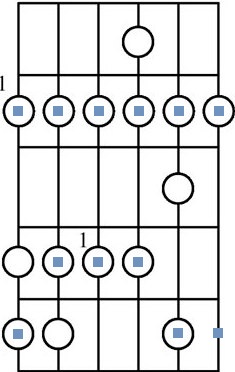Notes are the alphabet of music, and scales help you learn that alphabet by heart so that you can speak the language fluently. This comes much more easily on a piano keyboard: early on you can tell at a glance which key will produce which note, because everything is layed out linearly. On a guitar fretboard, however, it only comes with practice.
How it feels to play particular notes, and to move from one note to the next, will eventually stick in your brain so that the target note and the action required to produce that note become one and the same. It may seem a long way off, but, eventually, instead of having to think through where a note is, or how to get from one note to another, you’ll just know, and that will help you to improvise, sight-read sheet music, and compose your own music.
If you do a Google search for how to play scales on a guitar, you’ll often come across something called the CAGED system. For various reasons, this is not the system I’m using.
So far, the simplest system I’ve found – and one which is helping me get to know the fretboard – is something called the ‘notes-per-string’ system.
Using this system, you can play any major or minor scale on the guitar (the note you start on is the scale you will play). I find it helps me learn the fretboard if I focus on one scale at a time, and think each note name as I play that note. This is easiest in the scales of C major and A minor, which have no sharps or flats. Here we go!
(1) Major Scales

Image credit: http://www.dummies.com
This follows the tone pattern described in the major chord theory post. You can start on any fret, and the numbers represent in which order the notes should be played. Your fingers go:
low E string middle finger plays 1st note, little finger plays 2nd note
A string index finger plays 3rd note, second finger plays 4th note, little finger plays 5th note
D string index finger plays 6th note, ring finger plays 7th note, little finger plays 8th note (which also acts as the 1st note of the next octave)
G string index finger plays 2nd note (of next octave), ring finger plays 3rd note, little finger plays 4th note
B string middle finger plays 5th note, little finger plays 6th note
high E string index finger plays 7th note, middle finger plays 8th note
Play this all the way (two octaves) up, and then reverse it to go all the way back down. Be sure to keep your fretting hand in the correct position to enable you to play all the notes easily, with economical movement.
(2) Minor Scales

Image credit: http://www.dummies.com
This follows the tone pattern described in the minor chord theory post. You can start on any fret, and the numbers represent the 1st note of the first octave, and the 1st note of the second octave. Your fingers go:
low E string index finger plays 1st note, ring finger plays 2nd note, little finger plays 3rd note
A string index finger plays 4th note, ring finger plays 5th note, little finger plays 6th note
D string index finger plays 7th note, ring finger plays 8th note (1st note of next octave)
G string index finger plays 2nd note (of next octave), middle finger plays 3rd note, little finger plays 4th note
B string index finger plays 5th note, middle finger plays 6th note, little finger plays 7th note
high E string index or middle finger plays 8th note
Play this all the way (two octaves) up, and then reverse it to go all the way back down. Be sure to keep your fretting hand in the correct position to enable you to play all the notes easily, with economical movement. You can see in the next image how this minor scale relates to a scale we already know: the minor pentatonic (coloured positions).

Understanding Minor Scales
You can see here that the first difference between the major and minor scales is the third note, which has been flattened by a semitone in the minor scale. Amazingly, it’s this flattened third note that gives the minor scale its melancholy feeling.
What you’ve just learned to play is the ‘natural’ minor scale. From it, you can derive the ‘harmonic’ minor scale, in which the seventh note of the scale is raised by a semitone (move the 7th position on the diagram above up a semitone in each octave – this will mean you will play the 7th note of the final octave on the high E string instead of on the B string).
The purpose of the harmonic minor is to create musical tension that wants to resolve the 7th note onto the next note (the ‘home’ note of the scale). The harmonic minor is used more often than the natural minor in popular (Western) styles of song-writing; we’ll get into this in more detail in a future post.
There is another form of the minor scale, called the ‘melodic’ minor, in which the 6th and 7th degrees of the scale are each raised by a semitone going up, but then played naturally again coming down. If you play the piano, you will probably be most familiar with melodic (rather than natural or harmonic) minor scales.
To understand the different minor scale forms better, you may find this video useful:
That’s it! Now you can play any major, minor, or pentatonic scale. Do you have any helpful hints/tips for playing scales on the guitar? Tweet at me (@acnotesblog), find me on Facebook, or leave a comment below.
Happy playing!
P.S. Song of the day: We Are Young by Fun (ft. Janelle Monae)
If you like We Are Young, please consider helping to support Acoustic Notes by getting it here.
RELATED POSTS
understanding the pentatonic scale
